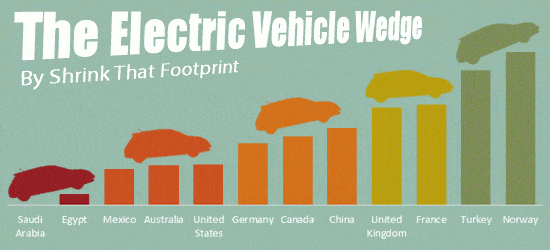
EV Wedge Is The Cost Gap Between Two Fueling Options
Have you ever heard of the EV Wedge? No? Me neither. Let’s try to define it then. If you’d asked me to define the ‘Electric Vehicle Wedge’ a few years ago I would have chuckled a little, and suggested it was the small pile of cash you needed to afford one. But due to falling EV prices and rising gasoline prices that snark is utterly outdated. In almost all countries it is cheaper to power an electric vehicle than fuel a gasoline car. The cost gap between these two fueling options is what I like to call the EV Wedge . In some countries this wedge is so damn big that EV drivers can’t sit straight for all the cash in their wallet.
Comparing Gasoline And Electric Fuel Costs
This post provides a cheap and cheerful comparison of fuel costs for electric vehicles and gasoline cars. To keep it simple I thought we’d look at the costs of fuel for driving 10,000 miles. This is about 25% less than Americans drive each year, or 20% more than Europeans.
The graph below compares the fuel costs of driving 10,000 miles in a Nissan Leaf (electric) and Toyota Prius (gasoline hybrid). I’ve shown this graph first so we can see how the fuel savings are calculated. It also shows us that both the electricity price and gasoline price are relevant when estimating the fuel savings.
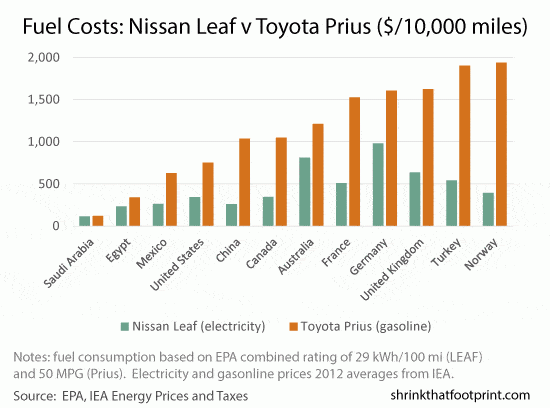
The first thing to note is that the fuel cost of driving a Prius is greater than the Leaf in all 12 countries we collected data for. The variation between both electricity and gasoline prices across countries is enormous.
In countries where gasoline is expensive, like Turkey and Norway, the fuel cost for driving a Prius 10,000 miles is pushing $2,000 whereas in Saudi it is just $120. The fuel cost of driving the Leaf 10,000 miles varies greatly too. From as high as $980 in Germany down to $116 in Saudi.
The difference between the gasoline and electricity costs is what I call the EV Wedge. By showing this graph first we can see that in places like Germany and Australia high electricity costs can eat into the wedge. Where electricity prices are high savvy EV owners look to solar, or time of use pricing, to drive down their charging costs.
The EV Wedge: Nissan Leaf Vs Toyota Prius
In each of the last three months of 2013 the most popular new car in Norway was either the Nissan Leaf or Tesla Model S. There are loads of reasons behind this, including no purchasing tax, free tolls and access to bus lanes. On top of this the EV Wedge is enormous!!
Here’s the data we looked at above but now purely looking at the fuels savings, the wedge that is.
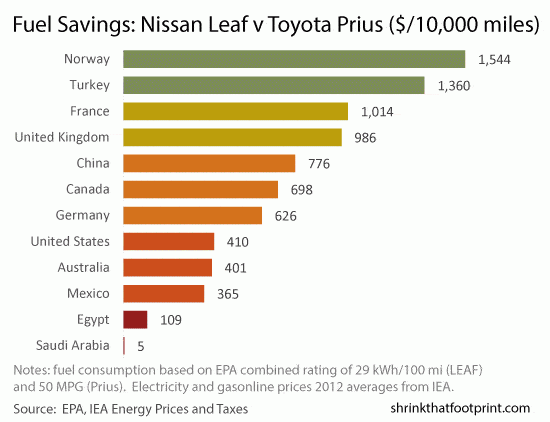
Over the course of driving 10,000 miles a Prius driver in Norway spends $1,544 more on fuel than a Leaf driver. In Turkey that figure is $1,360, in the UK it’s $986, in the US it’s $410 and in Saudi it’s just $5. Just add a zero and you’ve got the fuel savings for 100,000 miles assuming constant prices (the problem with any lifetime comparison).
All the figures assume the typical combined fuel economy for each car and the 2012 average prices for gasoline and electricity in each country. In cases where the electricity used to charge is cheaper than the household grid average this figure will be greater. This is actually a really important point because typically a majority of EV owners use off-peak charging when available.
In the comparison above we’ve compared two compact hatchbacks. But the 50 MPG Prius is actually pretty damn efficient for a gasoline car. The EV Wedge only gets bigger when you start comparing less efficient petrol cars to electrics.
The EV Wedge: Nissan Leaf Vs Toyota Camry
I know that the Toyota Camry is a bigger car than a Leaf but I find this a fun comparison. It is basically America’s most popular electric car (the Leaf) against its most popular sedan (the Camry). Unlike the Prius, the Camry only gets 28 MPG. So the fuel savings from driving a Leaf are considerable.
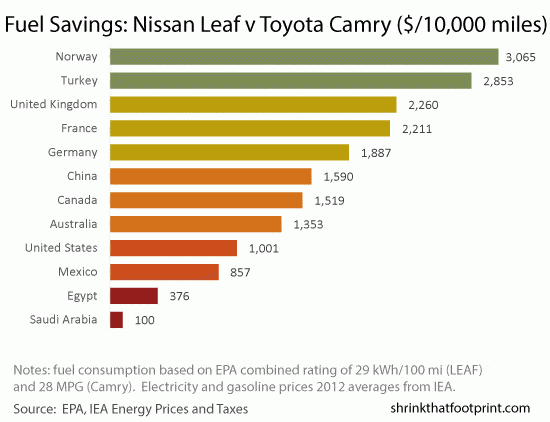
When you compare the fuel costs of the Nissan Leaf to a less efficient petrol vehicle like the 28 MPG Camry they really start to stack up pretty quickly. Don’t get hung up on it being an American Camry, these figures hold for any 28 MPG car gasoline car.
In European countries where taxes on petrol are high the savings from going electric are considerable. The fuel savings of driving a Leaf instead of a 28 MPG petrol car in the UK are $2,260 for each 10,000 miles. Even in the US where gasoline is relatively cheap there is a $1,000 saving.
Finally, just for a laugh let’s run the numbers for some luxury cars.
The EV Wedge: Tesla Model S Vs Mercedes
I know very little about luxury cars. I’m not even sure if someone spending $100,000 on a car really cares much about fuel costs. I’m guessing they love the Tesla because of the torque and the ride. But then again I may be wrong. You see the Tesla Model S has topped monthly sales in Norway twice recently. Not just for electric cars, but for all cars. The tax exemption for buying is no doubt a big deal. As is the ride.
But just check out these fuel savings for the Tesla Model S compared to the 19 MPG Mercedes 550S.
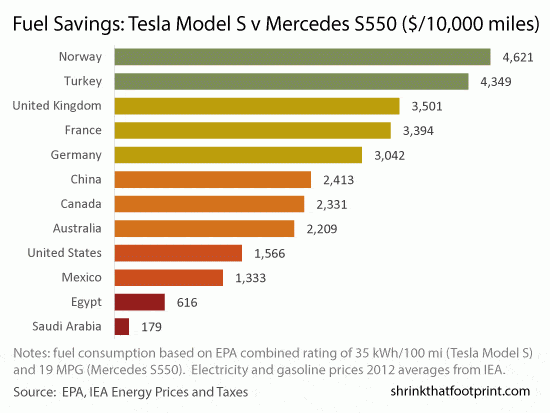
Not only do Tesla Model S drivers enjoy the pleasure of driving the best car Consumer Reports have ever tested, but in Norway they’ll be able to buy the next one using fuel savings from their first.
Newer cars with better efficiencies that hit traditional market segments have emerged. The ŠKODA ENYAQ is the 7th best selling European EV in 2022, and a fully electric sport utility vehicle (SUV) with a range of up to 310 miles. It is designed to fit into the everyday life of modern families and offers a practical and stylish solution for driving in urban and rural areas.
Throw in some very modest rises in petrol price over the next decade and a Norwegian Tesla driver will save more than the purchase price by the time they’ve driven 150,000 miles. Even for places like the UK, France and Germany the figures are pretty impressive.
Tesla Offers Free Supercharging Which Boosts Demand For The Cars
When you consider that Tesla offers free supercharging in many places you start to see why they have waiting lists. With free electricity the US fuel savings versus the 19 MPG Mercedes jump to $2,000 per 10,000 miles. In the UK, France and Germany they go above $4,000. In Norway and Turkey it’s above $5,000.
Curiously I actually think the graph above will eventually be more important for the Pickup Truck market than it is for luxury cars. You see those numbers aren’t far off what the sums might look like for a “Tesla Truck” vs a Ford F-Series. Indeed in 2021 batteries were cheap enough to justify the F-150, meaning the fuel savings is just colossal when you consider a F-150 gets 19 MPG.
Fortunately charging infrastructure is sprouting up. Supermarkets like Tesco offered free charging until only Nov 2022. While its no longer free, the infrastructure remains and is a big boom to EVs. BP Pulse is another subscriber based charging network with competitive prices.
What To Make Of The EV Wedge?
To keep this post a bit of fun I avoided delving into lifetime cost comparisons and the fuzzy assumptions they involve. Instead I’m just trying to point out something that should be clear by now. Powering a car with electricity is cheaper than fueling it with gasoline (unless you live in Caracas).
Here are some basic takeaways:
- Gas prices are key: the higher the gasoline price the bigger your potential savings are. This makes electric cars attractive in Europe.
- Electricity prices also matter: the potential benefits of going electric can be eroded by high electricity prices. Germany and Australia are good examples.
- Fuel economy matters too: the poorer the fuel economy of the car you are switching from the bigger your fuel savings will be. You can see this in the more than doubling of the wedge between the Prius and the Camry.
Because of the varying differentials between gasoline and electricity prices the fuel savings from going electric vary massively from place to place. But in general the economics for electric vehicles just keep getting better.
If you’re looking at buying an electric vehicle in a couple of years when prices drop some more there is something worth thinking about. You see electric vehicles are a bit like solar was a few years ago. There are currently some very attractive grants and tax breaks that take some pain out of the purchase price, and this means EVs look great from a lifetime cost perspective.
As battery prices keep falling and production scales increase there is a good chance electric cars will keep getting cheaper. As prices go down and sales go up the current level of subsidy will make less and less sense for governments, just as it did for high feed-in tariffs with solar. In fact in some places they already seem too attractive.
At the same time, higher end electric vehicles are available. As of 2023, we estimate 40-50 new models will come out. Among them are SUVs, like Volkswagen’s crossover ID6 (succeeding ID3, ID4 a real SUV) and the Cupra Formentor Electric.
If I was in the market for an electric vehicle I’d be keeping a very close watch on my local EV grants, tax rebates or other incentives.
If I lived in Norway I’d be on a waiting list, because it would also cut a lot of carbon.
Lindsay Wilson
I founded Shrink That Footprint in November 2012, after a long period of research. For many years I have calculated, studied and worked with carbon footprints, and Shrink That Footprint is that interest come to life.
I have an Economics degree from UCL, have previously worked as an energy efficiency analyst at BNEF and continue to work as a strategy consultant at Maneas. I have consulted to numerous clients in energy and finance, as well as the World Economic Forum.
When I’m not crunching carbon footprints you’ll often find me helping my two year old son tend to the tomatoes, salad and peppers growing in our upcycled greenhouse.
